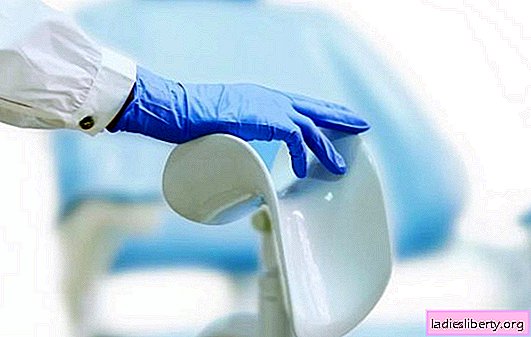
Polyp of the cervix (cervical polyp) is a pathological growth of normal endocervix (epithelial cells of the cervical mucosa).
According to the latest statistics, this pathology takes first place among benign neoplasms of the cervix and accounts for 4% of all diseases of the female genital organs. It occurs mainly in women in the menopause in the age after 45 years.
Cervical polyp is a background disease. If it is present, a malignant process in the cervix is not excluded in the future. Malignancy is observed in 1.5 - 2% of cases. But even such a minimal risk cannot be ignored.
Polyp of the cervix - causes
With a polyp of the cervix, the causes of its development are not well understood. There are risk factors that under certain conditions lead to the formation of a cervical polyp:
• chronic inflammation (endocervicitis, erosion, leukoplakia);
• STI - sexually transmitted infections;
• surgical interventions (abortion, uterine sounding, diagnostic curettage);
• hormonal surges (during pregnancy) 4
• pathology of endocrine organs;
• obesity;
• chronic stress;
• immune disorders caused by overwork, stress, depression.
In this way, with a developed cervical polyp, the causes of its formation are:
• chronic inflammation of various etiologies;
• hormonal imbalance;
• the traumatic effect of various factors on the epithelium of the cervix.
Polyp of the cervix - signs
With a detected polyp of the cervix, the signs that play a role in the formation of clinical manifestations and the course of the disease are as follows:
• education size: from several millimeters to 2 centimeters;
• quantity: the polyp can be single or multiple;
• by structure, polyps are divided into glandular, fibrous, adenomatous (atypical), glandular - fibrous.
Polyp of the cervix - the first symptoms
When a cervical polyp occurs, the first symptoms appear when the size of the formation becomes so large that it blocks the cervical canal. At the initial stages of development, polyps do not cause any sensations and, basically, are asymptomatic. It is detected as a find on ultrasound, during colposcopy or when examined in the mirrors.
An existing cervical polyp can occur with:
• infection;
• inflammation;
• injury.
In such cases, with a polyp of the cervix, the first symptoms are:
• drawing pains in the abdomen, which intensify before menstruation;
• a significant increase in the amount of leucorrhoea;
• bloody discharge during trauma to the polyp.
The latter is due to the fact that the cervical polyp contains a large number of vessels. In case of any even minor injuries (insertion of a vaginal swab, gynecological examination or intimacy), contact spotting appears.
In the future, as education grows, the following occur:
• various disorders of the menstrual cycle associated with regularity, duration, profuse bleeding or meager periods;
• infertility.
Polyp malignancy is possible, which manifests itself:
• hyperplasia (growth of the epithelium);
• metaplasia (transformation of one type of epithelium into another);
• dysplasia (the appearance of precancerous cells in the epithelium, which under certain conditions transform into cancerous cells);
• malignant process.
The appearance of a polyp during pregnancy dramatically increases the likelihood of spontaneous abortion (mainly for short periods), and also causes other complications (isthmic - cervical insufficiency or low placenta location). Usually found in pregnant polyp is removed only after childbirth. But if its diameter is more than 1.0 cm or it is bleeding, or causes pain and discomfort, emergency measures are required - the polyp is removed.
With the sudden appearance of spotting spotting during menopause, regardless of their frequency, duration or quantity, they must be considered as a symptom of a likely oncological process in the cervix or hyperplasia (proliferation of the epithelial layer). If a woman appears during menopause after a prolonged absence of menstruation, even minor spotting is necessary to immediately consult a gynecologist.
Polyp of the cervix - treatment
In the presence of a cervical polyp, the treatment is to remove the polyp. This is the only way to cope with a growing polyp, and no folk methods and grandmother's recipes will solve the problem. The drug effect in this case is meaningless. If the detected polyp is not removed, this is fraught:
• development and maintenance of a chronic infection;
• bleeding;
• infertility;
• malignancy.
Surgical removal consists of twisting the legs, curettage of the epithelium of the mucosa and cauterization of the polyp bed.
Several methods of non-drug exposure to the cervical polyp are used:
1. The hysteroscopic method - the most painless and safe, is carried out using a hysteroscope - a special optical device.
2. Diathermocoagulation - "cauterization" with an "electric" knife. In this way, polyps on a wide stalk are removed, after the operation, a scar remains.
3. Cryodestruction - "freezing" with liquid nitrogen. It does not leave scars, but wound healing is long - almost a month. It is used in nulliparous women.
4. The radio wave method - the polyp is "evaporated" using high-frequency waves. Inflammation or any infection is a contraindication to the procedure.
5. Laser removal: the polyp is seized with a special loop and the laser “cuts” its leg at the base. It is used for small single uncomplicated polyps on the leg.
If there is a constant recurrence of cervical polyposis, a conical resection of the cervix is performed. Removal of the polyp in pregnant women is indicated if the size of the formation exceeds 1.0 cm and its growth continues, or necrosis, inflammation, malignancy occurs. After the operation, a repeated examination of the gynecologist is required after 3 weeks.
Before surgery, a mandatory examination is performed for STIs and bacteriological smear smears from the cervical canal. In the presence of infection, a course of treatment is carried out and its effectiveness is subsequently monitored (tests are repeated).
After the removal of the formation, a biopsy is performed to determine the benignness or malignancy of the process, according to the result, further therapy is prescribed - hormonal or anti-inflammatory.
Complications after cervical polyp removal
Complications after surgical treatment may include:
• relapse;
• thermal burns;
• stenosis and stricture of the cervix, developing as a result of cauterization.
In the next two weeks after surgery, there are mucous or bloody discharge, soreness in the lower abdomen. Special therapy is not required, the symptoms quickly disappear. During this period, you can take painkillers or antispasmodics (But - shpa, Spazmalgon, etc.).
It is not recommended to take aspirin, as well as:
• bathing in the bath, visiting the sauna, baths;
• use of tampons (only pads);
• having sex;
• heavy physical exertion, stress, overwork.
The methods of traditional medicine are widely advertised as an effective way to treat cervical polyps. But in practical medicine, cases of the complete elimination of polyps in the treatment of folk remedies are unknown.
Cervical polyp - prevention
It is difficult to prevent the occurrence of a polyp. With a cervical polyp, prevention consists of a gynecological examination twice a year, even if there are no complaints. In the presence of STIs or inflammatory diseases of another etiology, timely treatment is necessary.
It is also necessary:
• eliminate stressful situations and depressive states;
• to refuse from bad habits;
• mandatory use of barrier contraceptives;
• timely treatment of concomitant chronic diseases and hormonal disorders;
• Do not sunbathe for a long time in the sun, because ultraviolet light can provoke the appearance or malignant degeneration of an existing polyp.
Continuous care for women's health will significantly reduce the risk of cervical polyps.











